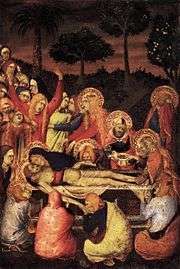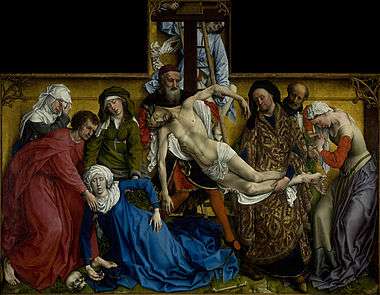Seilern Triptych

The Seilern Triptych (or Triptych with the Entombment of Christ), variously dated c. 1410-15 or c 1420-25[1][2][3] is a large oil and gold leaf on panel, fixed winged triptych altarpiece by the Early Netherlandish painter Robert Campin.[4] It is the earliest of two fully intact triptychs attributed to him.[5] It details the events of Christ’s passion; the iconography has been established as associated with the liturgy of Holy Week. The panels from left to right detail three stations of the cycle of the Passion of Jesus; the crucifixion, the burial and the resurrection.[6]
Campin was one of the very early founders of the Northern Renaissance,[4] and famed and successful in his lifetime for his breakthrough use of oil paints, but was largely forgotten during the early and early-modern period. He was rediscovered during the late nineteenth century, and has since been described as "one of the great religious paintings of the 15th century". Although Campin's life is relatively well documented for the time, there are no surviving records of this commission, and at 60 x 48.9 cm it is too small to have functioned as a church altarpiece - possibly it was intended for private devotion. The triptych represents one of the earliest extant Flemish paintings. Its iconography is related to the Depositio and Elevatio liturgical ceremonies.
Highly influential, the triptych is named after its former owner, the Count of Seilern, who bequeathed it to the Courtauld Institute on his death in 1978. It is today housed at the Courtauld Institute, London.
Description
The triptych may have functioned as a funerary altarpiece for a church, or given its relatively compact size, for private devotion.[7] There are no paintings on the exterior, although there may originally have been so. If the work was used in a church, the wings would have been closed except for special occasions such as funerals, and Church holidays.[8]
Each of the gold-leaf backgrounds contain wrapping vines, symbols of Christ and painted red currants, both symbols of Christ, the vines of the wine of the Eucharist.[9] The center panel is double arched.[7][10] It is to be read narratively from left to right, with panels showing the crucifixion, entombment and resurrection of Christ.[4] Each of the panels emphasised a different part of the pictorial space; the left hand panel is focused on the foreground and far back ground, the center panel with the foreground, and the right hand panel with the mid-ground.[8] There are a number of unifying elements across the panels, including the strong use of a deep red, and the presence of a dong in each of the wings.[8]
Left hand panel
The left panel shows the crucifixion scene, but in the aftermath of the Descent from the Cross, suggested by the ladder resting against the central, empty cross.[6] Especial detail is given to the thieves hanging in torment in the left hand panel, still alive, bound by rope to their crosses and left there even after Christ has been brought down and laid to his tomb.[11] The landscape outlines the hill of Golgotha. It is not especially detailed, and lacks perspective.
The donor kneels in veneration in the foreground, a Speech scroll or banderole eminitating from his lips. . He is presented in the scene with out an interceptor, usually at the time this would be a patron saint. His placement in front of an empty cross is highly unusual, but may reflect that donor's devotion to the True Cross.[7] He wears a red garment draped over his shoulder, a colour associated with the triumphant risen Christ.
Center panel

The figures in the center panel are significantly larger and more volumetric, or solid, than those in the wings.[8] Although the panel is connected to the wings by the continuous skyline, the scale and temporal setting of the central panel is very different to that of the wings. The scale is much reduced, and the figures far more tightly compacted, bring them much closer to the viewer, setting the scene with a far shallower and less realised space than the wings.[12] Their prominence in the pictorial space has at times been compared to concurrent trends in sculpture, especially by Claus Sluter.[13]
Christ's body is raised, perhaps awkwardly, on a shroud above the top slab of the sarcophagus. In this way the tomb is positioned, as described by art historian Shirley Blum, "the altar supporting Body and Blood of the dead Christ".[12] According to Barbara Lane becomes "both the celebrant and the sacrifice of the constantly repeated Mass".[9] The mourners gather around the tomb in a semi-circle, looking sorrowfully towards Jesus as he is wrapped in his burial shroud. They include Mary, Joseph of Arimathea (With a brown beard, dressed in pale (now) yellowish clothes and supporting Christ's head) and Nicodemus. Before the tomb, in the mid foreground are Saint John supporting the Virgin, a woman dressed in blue and holding a veil containing the face of Christ who is probably Saint Veronica, and in a symbol of the ritual act of anointing, Mary Magdalene rubbs oil on the feet of Christ.[6]
The portrayals of Joseph and Nicodemus are similar to those in Melchior Broederlam's Presentation. Strong emphasis is given to the shroud covering the body of Christ, a motif later seen in work Jean Michel and Georges de la Sonnette, two pupils of Sluter.

Two hovering angels carry the instruments of the Passion, including the sponge, nails and the crown of thorns,[6] represent the Crucifixion.[11] The two angels standing at either side of the tomb are in mourning. The one on the right wipes a tear from his face in grief.[11] This angel wears the liturgical vestments of the priest, including an alb and stole, indicating that he is about to perform mass. The angel to the right holds a spear, alluding to the crucifixion, and looks downwards towards the donor in the left hand panel, linking the narrative and panels together.[2]
The central panel has sometimes been compared to Italian equivalents, especially to Simone Martini's c 1334, Entombment, which, since it was taken to Dijon, Campin may have seen first hand.[14]
Right hand panel
The right hand panel shows the resurrection of Jesus. He stands on the tomb after it was opened by the angel sent by God, and holds the symbol of the Holy Cross as he raises his hands in blessing. Two soldiers sent by Pilate to protect the tomb and prevent the body from being stolen are in the foreground, at the foot of the tomb
Influence
The influence of the Seilern Triptych is discernible in works by major artists including Rogier van der Weyden,[15] Dieric Bouts, Quentin Massys, and Peter Paul Rubens.
-

Rogier van der Weyden, The Descent from the Cross, c. 1435
-

Dieric Bouts' especially mournful and now damaged The Entombment, c 1440-45
-

Jean Michel and Georges de la Sonnette, Entombment, c 1451-54
Notes
- ↑ van Gelder, 15
- 1 2 Recht, 253
- ↑ Lane, 21
- 1 2 3 Jacobs, 48
- ↑ Although the outer wing panels paintings are lost
- 1 2 3 4 Blum, 8
- 1 2 3 Jacobs, 45
- 1 2 3 4 Jacobs, 46
- 1 2 Lane, 26
- ↑ "The Seilern Triptych - The Entombment". The Courtauld Gallery. Retrieved 09 October 2016
- 1 2 3 McNamee, 75
- 1 2 Blum, 9
- ↑ Lane, 24
- ↑ Lane, 23
- ↑ Rogier likely studied under Campin as a member of his workshop
References
- Blum, Shirley Neilsen. Early Netherlandish Triptychs: A Study in Patronage. Berkeley: California Studies in the History of Art, 1969. ISBN 0-520-01444-8
- Jacobs, Lynn F. Opening Doors: The Early Netherlandish Triptych Reinterpreted. Penn State University Press, 2012. ISBN 978-0-271-04840-6
- Lane, Barbara. "Depositio et Elevatio: The Symbolism of the Seilern Triptych". The Art Bulletin, volume 57, issue 1, 1975
- McNamee, Maurice. Vested Angels Eucharistic Allusions in Early Netherlandish Paintings. Peeters, 1998. ISBN 978-9-0429-0007-3
- Recht, Roland. Believing and Seeing: The Art of Gothic Cathedrals. IL: University of Chicago Press, 2008. ISBN 978-0-2267-0606-1
- van Gelder, J.G. "Maitre de Flemalle, Triptych: the Entombment with a Donor and the Resurrection". London: Addenda to the Catalogue of Paintings and Drawings, 1971, No. I